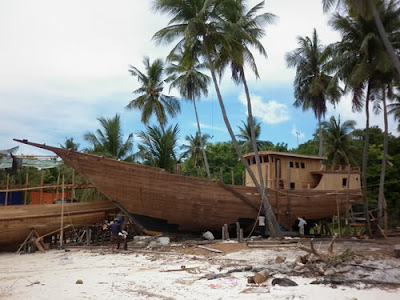-

Beautiful Lake Maninjau : West Sumatra Destination
Lake Maninjau is a volcanic lake that is located at 461,50 meter above the sea level. Its width is 99, 5 km2 with 4, 95 meter of the maximum depth. The existence of Lake Maninjau has created a folktale called "Single Sembilan" (The nine Bachelors). People living around the lake believe that those nine Bachelors are real...
-

Bantimurung Waterfall the Best Destination in South Sulawesi
Bantimurung waterfall (15 meters in height and 20 meters wide) is a very famous natural tourism destination in South Sulawesi. Pure water falls down from the crag every year. Beneath the waterfall, there is a bathing place made of limestone covered by mineral vein which is caused by the stream flow for hundred years....
-

Nimanga River, Best Rafting in North Sulawesi
Nimanga River is one of the most favorite tourism destinations in the North Sulawesi. It has been popular as it is used for any kind of extreme sports and other activities. It will be great experience for having an extreme sport such as rafting along the river...
Monday, March 18, 2002
The Center of Perahu Pinisi Industry
Wednesday, March 13, 2002
Cangkuang Temple
Cangkuang Temple was discovered firstly by Prof. Harsoyo and Drs. Uka Tjandrasasmita on December 19th , 1966. Both of them included into the researcher team of Leles history. It was discovered after receiving a report stated by Vordeman on the Notulen Bataviaasch Genootschap – published in 1893 A.D. – saying the existence of an ancient graveyard and the remain traces of Siwa Statue in Leles. Some other pre-historic age legacies were discovered on the next research. They were kendan stones (oxidant stone), pieces of earthenwares from the neolithic age and big stones from the megalithic age.
Having a look at the shape of the temple, some archaeologists assumed that the temple was erected in the eighth century. However, from the simple ornaments used, the making technique, and a chinese record, there is a prediction that the temple was built in the seventh century, on the same era as the building of Javanese temples.
Along the journey to the location, you will ride by Pulo Village which has the unique tradition and well-preserved traditional houses. By taking getek – raft made of bamboo – you will see the panoramic sight of Cangkuang temple that is awesome.
The atmosphere in Panjang Island, the location of Cangkuang Temple, is quite fresh and has imposing view because there is a beautiful park and the number of teureup tree, banyan trees, and randu tree (Ceiba pentandra). Moreover, the existence of Mount Haruman, Mount Mandalawangi, and Mount Guntur combined with the calm water of surrounding area can enhance the location as the worth visiting tourism destination for you.
A public small museum keeping many antique objects and 12 ancient books is located nearby the temple. Some documents telling the history and all information relating to the temple can also be found in the museum.
About a kilometer away from the museum, there is a tomb of Embah Dalem Arif Muhammad. It is believed that he was the envoy of Mataram Kingdom who was assigned to fight againts VOC in Batavia (Jakarta). After being defeated by VOC, he and his entourage decided to keep staying in Cangkuang where the local inhabitants there had embraced Hindu. Considering such reality, the location is a right place for cultural and natural tourism.
Cangkuang Temple Location
Thursday, March 7, 2002
Bledug Kuwu
Since the reign of old Mataram Kingdom (732 – 928 A.D.), bledug kuwu has been shaped out naturally from the volcanic mud in the district of Grobogan, Central Java, Indonesia. Over and above the existence of eternal fire resources of Mrapen and Kedungombo dam, Bledug Kuwu is the worth visiting tourism destination in Grobogan District, Central Java Province. Bledug Kuwu is derived from Javanese language, bledug means explotion/ to explode and kuwu/ kuwur means run or scattered about.
The early history of bledug kuwu was started when a man namely Joko Linglung was going home from the Pacific Ocean to Medang Kamulan Kingdom through a hole – that is now bledug kuwu – after defeating Prabu Dewata Cengkar. Joko Linglung made the hole himself as he was able to transform into a snake. Such ability was a requirement to be admitted as the son of Aji Saka, the roler of Medang Kamulan Kingdom.
Along the journey to bledug kuwu, you will see the natural view of thick forest, green farms, and beautiful hilly areas. In the location, you will see frequent small explotions of the mud every two to three minutes. The wallow mud area is 650 meters in diameter. Sometimes, the mud`s explotions can be as high as local inhabitants` houses.
The existence of bledug kuwu is utilized by local inhabitants for livehood resources by producing salt. The activity of local people in producing salt in the location is a distinction which is rarely found in the mainland. The expertise of local people in producing salt was recorded on the history of Surakarta Kingdom.














